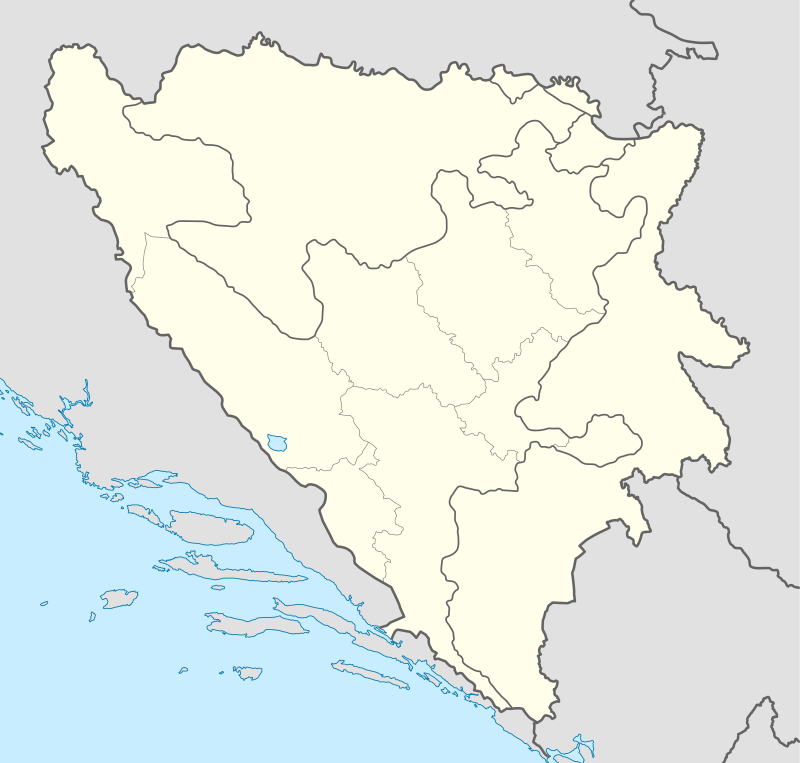Fortress of Doboj
| Doboj Fortress | |
|---|---|
| Doboj, Bosnia and Herzegovina | |
|
Doboj Fortress | |
 Doboj Fortress | |
| Coordinates | 44°44′13″N 18°05′17″E / 44.737°N 18.088°E |
Doboj Fortress or "Gradina" is located in the city of Doboj, Bosnia and Herzegovina.[1]
History
Construction
One of the most important defenses in the medieval bannate/duchy of Usora, this large stone structure was built in the early 13th century on the site of an earlier, clay and wood-based structure from the 10th or 11th century. In the first period of its existence, from early 13th to about early 15th century (1415), the fortress was built in the Romanesque architecture style. Throughout its turbulent history, this magnificent object has been burned and ransacked at least 18 times as per official records. Of note is that Doboj fortress was considered to be a royal Kotromanic property, unlike Great Bosnian Duke Hrvoje's Zvecaj fortress or Sandalj Hranic's Blagaj fortress, which were centers of their respective dukedoms.
Doboj fortress underwent a major reconstruction in the spring of 1415. While still retaining some of its original Romanesque elements, the fortress now displays Gothic structure and had its large keep reinforced with thick walls (up to 3 feet or about 1 meter thick at the Eastern wall) as well as having an addition of a bastion/plateau with six cannon on top of it. The captain's tower was turned into even more dominating feature with several stories tall square keep towering over the fortress. Additional outer walls were added around the original triangular core and three big towers (North-West, Eastern, and Southern Gate) have been strengthened as well. These towers strategically protect flanks of the fortress, hence rendering any idea of an attack a suicidal attempt. The Southern tower's walls, in particular, are changed into round shape in order to deflect cannonballs (circa 1370-1380s) and local captains at the time used Dubrovnik-made cannons, bombards, and balistas as fortress' main defense weaponry (Dubrovnik was known as Republic of Ragusa at the time).
Role in Battle of Doboj
In the early August of the same year, Bosnian nobility with its armies under command of The Great Bosnian Duke Hrvoje Vukcic-Hrvatinic in the coalition with Ottoman Turks under Isa-Beg fought the Hungarians in the Battle of Doboj (1415). During this campaign the Hungarians (under Johannes de Gara and Johannes de Maroth) had their main camp established on the field right under the fortress of Doboj while the actual battle took place in the area of Makljenovac, some 5 kilometers due south. The heaviest fighting took place on the plateau of the small village of Sevarlije, across the river Bosna from Makljenovac proper.
Approximately 15,000 Hungarians spread into three banderia faced the united Bosnian nobility which brought 10,000 knights and men-at-arms to the battlefield. Most important Bosnian overlords - Hrvoje Vukcic, Sandalj Hranic, Pavao Radenovic, and Vuk Zlatonosovic from Usora Bannate were present. In addition, there was up 15,000 Ottoman Turks under Isa-Bey that came to fight on the Bosnian side, arriving just in time from direction of Zenica and Lasva Valley. Encroaching Ottomans were already a real threat to Southeastern Europe since the fall of Serbian Empire in 1371. They were actively meddling in medieval Bosnian affairs since early 1400s and had a permanent garrison stationed in Vrhbosna as early as 1414. However, as it was typical of the fickle politics in High Middle Ages in Europe, Bosnians gladly accepted Ottoman help this time in order to hit back at Hungarians which were incessantly waging wars and Crusades against them for the better part of last two centuries. After careful positioning on the battlefield, the heavy cavalry charge opened the battle, with the smaller pockets of close quarter fighting subsequently developing on gentle slopes of the area set amidst rivers Bosna and Usora. As it happened, Hungarians were heavily defeated in this battle, with most of the present nobility captured and ransomed later on, and were not to undertake any major offensive against the Ottomans or Bosnian kingdom until the Second Battle of Kosovo in 1448.
More history
Turks had conquered the city of Doboj and its fortress in 1476 and in following decades had the fortress completely reconstructed and gave it a new shape by adding the second outer wall and additional structures. Particularly large works were done in the early summer of 1490 where some 1,500 men were employed under master-builder Ibrahim. This was necessary from a strategic point of view, as the northernmost borders of Ottoman Empire at that time were positioned in line Jajce-Doboj-Srebrenik. It appears that the fortress was briefly retaken by Hungarian and Bosnian forces loyal to short lived Hungarian-backed Jajce Banate (1463-1528). However, as officially recorded, from 1503 the old town Doboj and its nearby fortress are firmly in Ottomans' hands until 1878. In the Austrian/Turkish war (1697) Doboj fortress had been sacked and burnt by Prince Eugene of Savoy and his Austrian armies on the march to Sarajevo. The fortress had been conquered and burnt by Austrians again in the summer of 1717. In 1740, Turks added a torture chamber to the fortress's interior but its garrison at the time consisted of only 40+ standing soldiers. Doboj fortress gradually lost its military significance in the late 18th century as the Turkish borders shifted dramatically in the Austrian/Turkish Wars, and later Napoleonic wars on Balkans and elsewhere.
Capture by Austro-Hungarians and Role in World Wars
In 1878, Austro-Hungarian army captured the fortress after a very heavy and prolonged battle with a local population, mostly Bosnian muslims (Bosniaks today). A-H army had losses of nearly 1,000 soldiers killed in the battle around Doboj in the late summer of 1878, on its way to Sarajevo, and as it tried to establish hold in Northern Bosnia.
While strategically obsolete, of note is that fortress remained in use by A-H forces in WWI and it stationed a strong Croatian Ustasha and German Wehrmacht unit in WWII. This unit remained firmly entrenched on the fortress throughout the entire war. Members of German forces built additional impromptu bunkers surrounded by concertina wire in the early summer of 1941, and due to its location and firepower, Serbian villagers were unable to take this object during their uprising on August 23, 1941 while they successfully captured all other objects and installations throughout the city and completely destroyed remaining barricaded German/Ustasha units in Doboj and surrounding area. Several thousands Serb rebels, already under heavy Croatian Ustasha oppression since April 10 and establishment of Independent State of Croatia, managed to hold onto the city for 48 hours before being forced back across river Bosna as German armored units entered Doboj from Derventa/Brod and Tuzla area. In retreating through the streets of Doboj, they were under constant heavy fire from the fortress and had multiple casualties. The very last shots were fired from the fortress in early morning hours of April 17, 1945, as the elements of Yugoslav Partisan 53rd division and 14th Central-Bosnian Partisan Brigade stormed into the city from Southern and Eastern lines of defense.
Today
Despite some damages suffered from shelling during the Bosnian War, the fortress is very well preserved. In the late 2000's, it could be visited and was properly maintained. However, since the 2010s, the regular maintenance was abandoned and the castle was vandalized while the facilities gradually fell in decay. In 2016-2017, new works took place in partial conservation of the fortress along with new archeological diggings revealing medieval arrowheads, pieces of clay and glass and decorative pottery, and both elements of crude and fine metal work. The lower layers of three flanking towers, in particular, remain inadequately researched with much more potential for future digs and detailed and long lasting conversation of this historical structure.
 View of the ramparts and tourist facilities, in the 2000s.
View of the ramparts and tourist facilities, in the 2000s.- Same view, in 2014.
- Abandoned entrance.
- Vandalized interior.
- Abandoned amphitheater.
References
External links
| Wikimedia Commons has media related to Doboj Fortress. |
